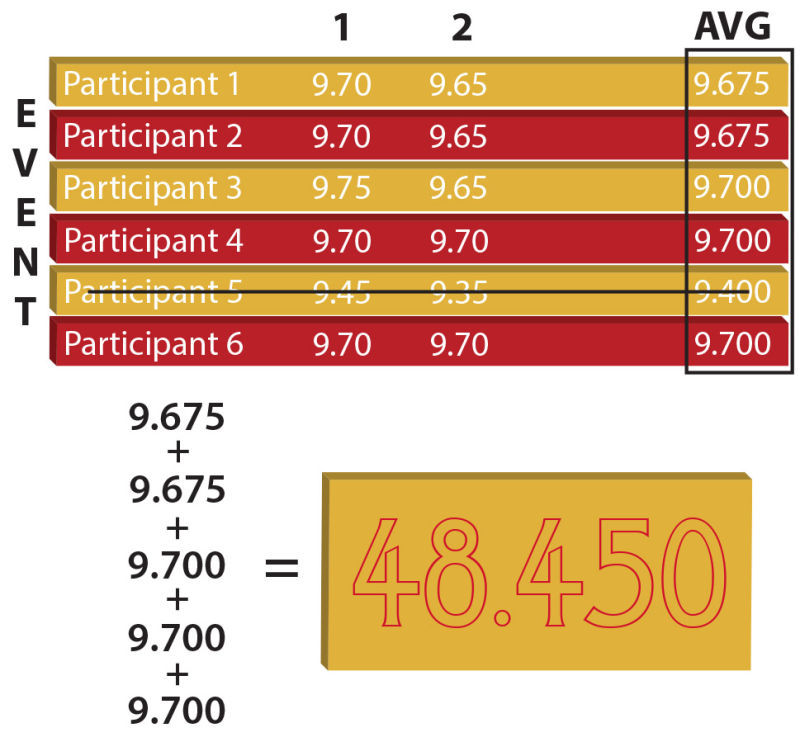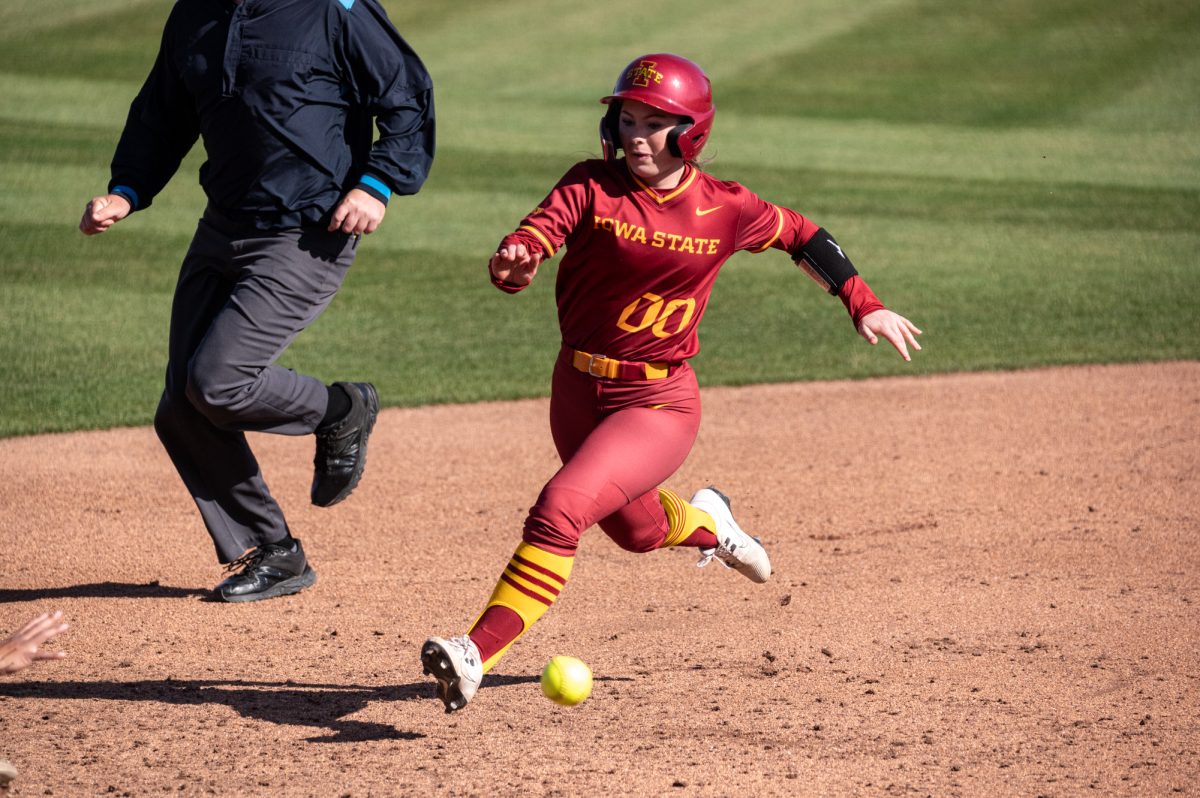Gymnastics 101: Iowa State coach, gymnasts explain gymnastics scoring
The above graphic is an example of how a gymnastics event is scored. Of the six participants, the top five scores are combined to create the team’s score for the first event. The same process is used for all events.
January 22, 2014
With the start of the new year just in the rear-view mirror, collegiate gymnastics season is officially underway. Like all other sports, gymnastics can be difficult to follow if the viewer has no clue what is going on.
Gymnasts soar through the air on the floor exercise and pull off combinations of flips and twists on the vault for what seems like a random score. There is, however, a method to the madness.
NCAA Gymnastics meets are comprised of four events: vault, balance beam, uneven parallel bars and floor exercise. Six gymnasts from each team perform on each apparatus with a chance to earn up to 10 points per routine. Gymnasts may, and often do, compete in multiple events in one meet.
For every event, there are two judges who score a gymnast’s efforts to a quarter-point based on the difficulty and execution of the routine. The two judges’ scores are averaged and that becomes the gymnasts score for that event. After all six competitors perform on an apparatus, the lowest of their scores is dropped and the remaining five are added for a score out of 50.
“[Judging is] pretty subjective,” said Iowa State’s head gymnastics coach Jay Ronayne. “The whole meet comes down to what those particular judges think, but there’s no way to always play to their liking. You’ve just got to do your best and hope they like it.”
Senior Hailey Johnson also noted that scoring can vary from meet to meet, citing the differences she has experienced in meets hosted by other conferences. She specifically acknowledged what the Cyclones will face in their next meet in Corvallis, Ore.
“The scoring will be a little bit different there,” Johnson said. “Big 12 scoring is a little tight. There’s definitely [more leniency] in PAC 12 and SEC scoring. It’s not to say that it’s easy, but there is a [trend] you start to notice.”
While a majority of the score is subjective to a judge’s opinion, other parts are set in stone. Each event has its own specific set of rules that, if violated, results in point deductions.
For example, if a gymnast does not land feet-first in the vault event, each judge deducts one point from their score. These types of falls are uncommon, but if they occur can be detrimental to a team’s overall score and chance of winning.
Among the most common, and often most impactful deductions are steps taken on landings. When dismounting from the vault, bars and beam or landing after a tumbling pass on the floor exercise, gymnasts cannot take steps to stabilize themselves without receiving one-tenth of a point deduction.
Sticking the landing seems intuitive, but the challenge comes from the flips and spins the competitors pull off while in the process of dismounting. Even though losing one-tenth of a point doesn’t appear terrible, senior Henrietta Green insisted that in the long run they are — and that’s something the team is working on.
“Getting those sticks with good form will be big,” Green said. “We’re all capable of hitting routines, it’s just going out there and fixing things that will get us those tenths [of points] on every event.”
In spite of the various ways to lose points, many gymnasts still earn marks at or above 9.700s and 9.800s. At Iowa State’s tri-meet versus Illinois State and No. 7 Michigan, 16 Cyclone competitors were rewarded with scores greater than or equal to 9.700.
According to Ronayne, high scores have become the norm for some of his gymnasts.
“Our three [gymnasts on floor exercise] that scored 9.800s and up, we expect that from them because they’re that good,” Ronayne said following the tri-meet with Illinois State and Michigan. “In fact, we need to get more of those and that’s what we need to focus on. [The Jan. 5 meet versus Penn State] was a disappointment because those scores weren’t there for us.”
In a bare-bones sense of it, scoring in gymnastics is the result of how well a gymnast can pull off a routine of a certain difficulty. While they may be difficult to calculate to the untrained eye, scores in gymnastics are far from arbitrary.
The intricacies are vital, however, as they can ultimately make the difference between advancing to nationals or ending a season.
“…That’s why [at nationals] they try to have the same couple of judges at multiple events,” Ronayne said. “We’ve actually tied in meets before — it’s been that close. Every little bit counts.”







